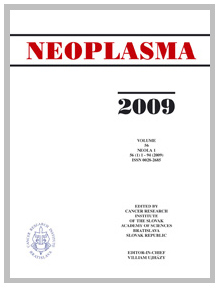Journal info
|
||
Select Journal
Journals
Bratislava Medical Journal Ekologia - Ecology Endocrine Regulations General Physiology and Biophysics Neoplasma 2025 Ahead of print 2024 2023 2022 2021 2020 2019 2018 2016 2017 2015 2014 2013 2012 2011 2010 2009 2008 2007 2006 2005 2004 2003 Acta Virologica Studia Psychologica Cardiology Letters Psychológia a patopsych. dieťaťa Kovove Materialy-Metallic Materials Slovenská hudba 2025Webshop Cart
Your Cart is currently empty.
Info: Your browser does not accept cookies. To put products into your cart and purchase them you need to enable cookies.
Neoplasma Vol.52, p.374-380, 2005 |
||
| Title: Second primary tumors (SPT) of head and neck. Distinguishing of “true” SPT from micrometastasis by LOH analysis of selected chromosome regions | ||
| Author: M., GIEFING ; M., RYDZANICZ ; K., SZUKALA ; A., WOZNIAK ; M., WIERZBICKA ; K., SZYFTER ; M., KUJAWSKI ; | ||
| Abstract: The reason of treatment failures in head and neck tumors is often connected with the appearance of second primary tumors
(SPT). Three mechanisms of SPT development of clonal or non clonal secondary tumors were described: 1° via
micrometastases (clonal); 2° from a common carcinogenic field – Second Field Tumors (SFT – partially clonal); 3° via independent
events (from different carcinogenic fields – “true” SPT – not clonal). Assessing the clonality of diagnosed tumors
carries important clinical implications including chemoprevention, radiotherapy and general patient management. In this study a set of 12 microsatellite markers was used to find similarities and/or differences in allelic imbalance patterns between 22 pairs of tumors (the first tumor designate as index and SPT). The aim of the study was to identify a potential clonal origin and progression within given pairs of tumors. The results indicate that within the tumors diagnosed by clinical examination as SPT at least two mechanisms mentioned above should be taken into account as 6/23 (26%) were clonally unrelated (“true” SPT) and 3/23 (13%) carried clonal genetic changes (formation by micrometastasis or SFT). In 14/23 (61%) cases the results were insufficient or ambiguous to determine the clonality status. The final results indicate the complexity of carcinogenesis in these tumors and thus stress that clinical diagnosis of second primary tumors should be considered carefully. |
||
| Keywords: second primary tumors, head and neck cancer, second field tumors, loss of heterozygosity | ||
| Year: 2005, Volume: 52, Issue: | Page From: 374, Page To: 380 | |
|
|
 download file download file |
|

